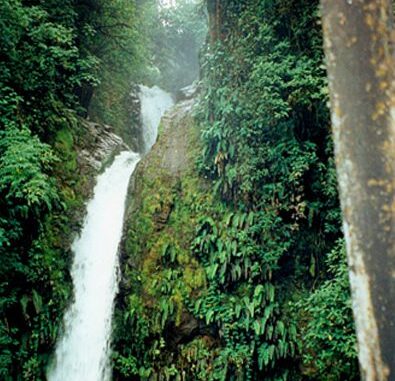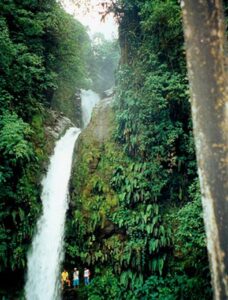

Rich Brommer
La Paz Falls, Costa Rica
Would you like to explore Spanish-speaking countries that offer thriving cities, fascinating indigenous villages, ancient ruins, thick green rain forests brimming with exotic animals and plants, spectacular volcanoes, pristine beaches, beautiful national parks and protected reserves, and one engineering marvel? If so, then you’d love Costa Rica and Panama! Located in the southernmost part of Central America, Costa Rica borders Nicaragua on the northwest, and Panama borders Colombia, South America, on the southeast.
Costa Rica’s only major metropolitan city is San José, the capital. Built from the profits of coffee exports, San José is located in the Central Valley, offering wonderful views of the surrounding mountains. Costa Rica is a land of exquisite Caribbean and Pacific beaches lined with coconut trees, exotic rain forests brimming with exciting wildlife, lush mountains with breathtaking waterfalls, and spectacular volcanoes—both active and extinct. In order to preserve Costa Rica’s natural beauty and diverse natural habitats, 27 percent of the land is protected, with 58 wildlife refuges, 32 protected zones, 27 national parks, 15 wetland areas (mangroves), 11 forest reserves, 8 biological reserves, and 12 other conservation regions. This green country, although small (slightly smaller than West Virginia), is one of the most biodiverse and ecofriendly countries in the world. No wonder the slogan of the Costa Rican Tourist Board is “Sin ingredientes artificiales!”
Panama is the southernmost country of North America. It has the fastest growing economy of any country in Central America, due in large part to the Panama Canal. The capital and largest city of Panama is Panama City, divided into the modern city and the original colonial district, casco viejo, founded by the Spanish in 1519. Mountains run down the center of the country, beautiful beaches line both the Pacific and Caribbean coasts, and, like Costa Rica, rain forests and wildlife abound. Panama City is the only Latin American city with rain forests just minutes away. These rain forests, such as Soberanía National Park and Chagres National Park, also surround the Panama Canal. Farther south is the Darién region, a vast area of dense and remote tropical rain forest. Indigenous groups such as the Emberá and Guna live in scattered villages along its numerous river valleys. This area is home to a rich variety of flora and fauna, so bring your binoculars and let’s go birding!
Explore More:
Can you figure out what Costa Rica means? Why do you think it was given this name? What is the origin of the name Panama? There are many theories as to how Panama got its name. Investigate these theories using Spanish-language resources and decide on the one you think makes the most sense. Prepare a report in Spanish that summarizes several of the theories and share it with your class. Survey the class to see which theory they think is the most logical. Do you all agree?